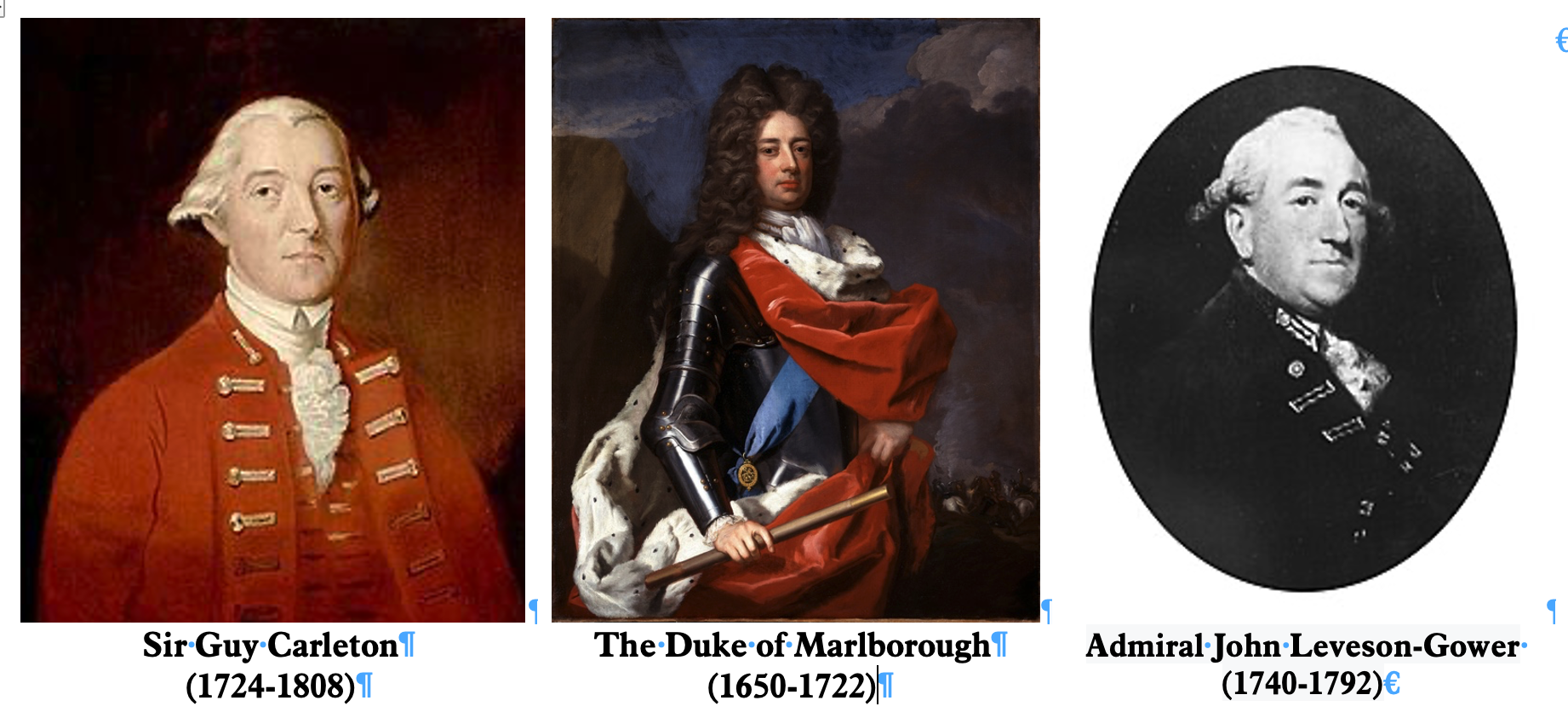What’s in a Name? Origin of the Names of Carleton County, and Marlborough and North Gower Townships

Source: "Nothing But Names: An inquiry into the origin of the names of the counties and townships of Ontario." HERBERT FAIRBAIRN GARDINER, M.A.. George N. Morang and Company Ltd., Toronto. 1899
Note: An abbreviated version of the histories below appeared in the Ottawa Journal, August 12, 1899
CARLETON COUNTY
THIS county got its name from Sir Guy Carleton, afterwards Lord Dorchester, born 1724, died 1808, who accompanied Wolfe s expedition to Canada and took part in the battle of the Plains of Abraham.
In 1770 Carleton went to England, but returned to Canada in 1774, and defended Quebec from the attack of Montgomery and Arnold. In 1782 Carleton succeeded Sir Henry Clinton as Commander-in-chief of His Majesty s forces in America. In 1783 he evacuated New York and withdrew the British ships from America. In 1786 he was made a peer, with a pension of ₤1,000, and sent to Canada as Governor-General, which post he held till 1796.
Carleton was a strict disciplinarian, but kind of heart, and very popular with the French Canadians. He married, in 1772, Lady Mary Howard, daughter of Thomas, Earl of Effingham, and died in 1808, aged eighty-three. Carleton county is named on the map of 1798, but was not then organized, or divided into townships, though portions of the present county of Carleton were included in Russell and Grenville counties.
MARLBOROUGH TOWNSHIP
"It was the Duke of Marlborough who put the French to rout, but what they fought each other for, I never could make out." ~Southey.
THIS township, which originally belonged to Grenville County, bears the name Charlborough on Smith’s 1798 map, either as a misprint for Marlborough, or from Charlbury in Oxfordshire, seven miles from Woodstock, near which village is Blandford Park, successively owned by the Earl of Danby, the Earl of Clarendon, the Duke of Marlborough and the Duke of Beaufort.
The Ontario township now called Marlborough is just north of Oxford on the Rideau, and as Blenheim Castle and Charlbury are both in Oxfordshire, either name is appropriate in that connection. John Churchill, Duke of Marlborough, son of Sir Winston Churchill, was born at Ashe, Devonshire, in 1650. King James II. made him a peer, with the title of Baron Eyemouth, in 1682, and he was created Lord Churchill in 1685.
King William III. made him Earl of Marlborough in 1689. He took Liege in 1702 and Queen Anne made him Marquis of Blandford and Duke of Marlborough in 1703. With Prince Eugene he conquered the French at Blenheim in 1704, and for that he received the grant of the manor of Woodstock. In 1706 he fought the famous battle of Ramilies.
He died in 1722, in the reign of George I., and his remains were interred with great pomp in Westminster Abbey. The town of Marlborough in Wiltshire, from which the Duke s principal title was taken, is named from its situation at the foot of a hill of chalk or marl. It was mentioned in Domesday Book and became a place of importance after the Norman Conquest, when a castle was erected, of which some traces are still visible. A Parliament was held at Marlborough in the fifty-second year of King Henry III's reign.
NORTH GOWER TOWNSHIP
GOWER township took its name from Admiral the Hon. John Leveson Gower, second son of the first Earl Gower, born 1740, died 1792, who distinguished himself as the Commander of Quebec and at the relief of Gibraltar, 1782; and was Lord of the Admiralty, 1783-89.
When Prince William was third lieutenant of the Hebe frigate in 1785, the Hon. John Leveson Gower hoisted his broad pennant on board, and proceeded on a cruise round Great Britain. His Royal Highness on that occasion saw more of his native country than any British monarch had ever seen before.
Sir Granville, second Earl Gower, elder brother of the preceding, born 1721, created Marquis of Stafford 1786, died 1803, was a member of the House of Commons and filled various Ministerial offices 1744-54; was President of the Privy Council 1768-79 and 1783-94. Earl Gower and Hon. J. L. Gower both voted in favor of the Canada Bill.
Earl Gower’s son, George Granville Gower, second Marquis of Stafford, became Duke of Sutherland, and his second son became Earl and Viscount Granville. The second son of the first Duke of Sutherland (grandson of Earl Gower, first Marquis of Stafford), became Earl of Ellesmere. The poet Gower, contemporary with Chaucer, was born at Swansea, in Glamorganshire.
